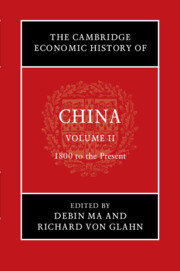Book contents
- The Cambridge Economic History of China
- The Cambridge Economic History of China
- The Cambridge Economic History of China
- Copyright page
- Contents
- Figures
- Maps
- Tables
- Contributors to Volume II
- Acknowledgments
- Note on Citations
- Introduction to Volume II
- Part I 1800–1950
- 1 Ideology and the Contours of Economic Change
- 2 Economic Transition in the Nineteenth Century
- 3 Agriculture
- 4 Handicraft and Modern Industries
- 5 The State and Enterprises in Late Qing China
- 6 State Enterprises during the First Half of the Twentieth Century
- 7 Money and the Macro-economy
- 8 Public Finance
- 9 Financial Institutions and Financial Markets
- 10 Chinese Business Organization
- 11 The Economic Impact of the West
- 12 Foreign Trade and Investment
- 13 Transport and Communication Infrastructure
- 14 Education and Human Capital
- Part II 1950 to the Present
- Index
- References
12 - Foreign Trade and Investment
from Part I - 1800–1950
Published online by Cambridge University Press: 07 February 2022
- The Cambridge Economic History of China
- The Cambridge Economic History of China
- The Cambridge Economic History of China
- Copyright page
- Contents
- Figures
- Maps
- Tables
- Contributors to Volume II
- Acknowledgments
- Note on Citations
- Introduction to Volume II
- Part I 1800–1950
- 1 Ideology and the Contours of Economic Change
- 2 Economic Transition in the Nineteenth Century
- 3 Agriculture
- 4 Handicraft and Modern Industries
- 5 The State and Enterprises in Late Qing China
- 6 State Enterprises during the First Half of the Twentieth Century
- 7 Money and the Macro-economy
- 8 Public Finance
- 9 Financial Institutions and Financial Markets
- 10 Chinese Business Organization
- 11 The Economic Impact of the West
- 12 Foreign Trade and Investment
- 13 Transport and Communication Infrastructure
- 14 Education and Human Capital
- Part II 1950 to the Present
- Index
- References
Summary
By the mid-eighteenth century, the Qing dynasty (1644–1911) was the dominant power within Asia. Its political system and institutions of state building were founded on structures inherited from previous Chinese dynasties as well as on the social and cultural codes of interaction among polities across Central Eurasia, East Asia, and Southeast Asia. Foreign trade between China and other countries within and outside Asia was a calculated matter of political strategy and economic gain. In the decades leading up to the First Opium War of 1839 to 1842, China’s stance with respect to the Sino-Western trade became increasingly at odds with British ambitions in Asia. The growing tensions stemmed from abiding differences in the political economy of not just two nations, but two empires. The overseas influence of the British Empire took on a forceful new impetus with the British Industrial Revolution, and, over the nineteenth century, technological improvements in transport continued to power Western expansion in global trade.
Keywords
- Type
- Chapter
- Information
- The Cambridge Economic History of China , pp. 414 - 456Publisher: Cambridge University PressPrint publication year: 2022
References
Further Reading
- 1
- Cited by

